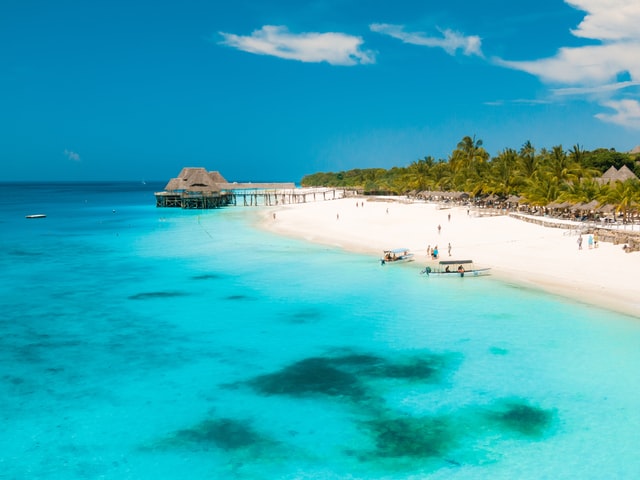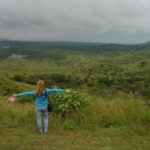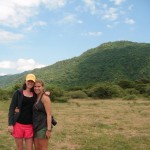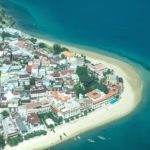Spice of Life: Zanzibar Travel

Reluctantly, we leave Stone Town. I would happily spend weeks exploring its nooks and crannies. Our bus idles outside of the Dhow Palace and we board for our tour of a spice farm, Persian baths and a home cooked meal.
We arrive at the spice farm, a short drive from Stone Town. We are introduced to our guides who will inform us in words, tastes, touch and smell the reason Zanzibar is called the Spice Island.
We stop at an unknown plant. The young man cuts a piece for us to touch and smell. It is now clear, lemongrass. The tour is an education and delight. We learn that there are male and female nutmeg trees. Only female trees bear fruit; however the sex of the tree is not determined for six to eight years. I imagine how disheartening it would be to care for a tree for many years only to have it worthless. In an attempt to make up the sterility of the male tree, the female tree bears two spices, mace and nutmeg. We sample each. Mace has a slightly sweet taste while nutmeg’s is earthier.
I imagine how disheartening it would be to care for a tree for many years only to have it worthless.
We smell a plant with a flowery aroma, mlangi langi. We are told it is used to create perfumes. We carry it with us loving the scent. We sample a plant used as natural lipstick and adorn our lips. While walking, the men have been weaving palm fronds. At first I think they are only passing time until they present us with their talented creations. We are adorned with bracelets, rings, necklaces, hats and ties, a memento of this day. We are very fancy as we continue our walk through the Plantation.
We pass an Islamic school where the employee’s children are educated. They are as curious of us as we are of them. We take their picture and they take ours. Their families live in homes just behind the school. The plantation seems like a nice place to live, work and play among the spice, though I wonder about the isolation of this life.
We reach a small clearing and stand among coffee plants. A flash mob of vendors descend selling homemade soap and perfume. Momentarily, it strikes me as odd to buy goods in the bush, then I shrug my shoulders and move closer for a better look. Bartering exists in the jungle. We dance the haggle dance and I leave with my fair priced goods.
We round a bend and find seating. We rest and are soon treated to a remarkable display of athleticism. A young man attaches a foot rope with a loop for each bare foot and a length of rope in between. He uses the rope to inch up a large palm tree and we watch him climb about 50 feet from the ground. He barely breaks a sweat and even sings and dances. We shake our heads in disbelief. He brings down a large coconut, breaks it open and we all share the sweet milk, and soft meat. I have eaten coconut before though it’s clear that today is the first day I’ve actually tasted coconut.
We sample Jack fruit, a blend of banana and pineapple. It can grow up to 100lbs and when less ripe tastes like chicken, making it an alternative for vegetarians. It’s an odd looking plant, appealing to photograph, as I snap one picture after another trying to discover its best side. We watch the ease of Cassava planting, sticks put in the ground, the woman barely breaks a sweat as she sows the row. Cassava is incredibly versatile. It can be baked, boiled, fried, steamed grilled or mashed. We learn that it must never be eaten raw as death by cyanide poisoning will occur.
We are motioned towards an open air spice shop. We peruse the many options, haggle and buy. We likely have bought too much, though the understanding of the various spices, coupled with their fresh taste, has our taste buds dancing with the possibilities of the dishes we will create at home.
Momentarily, it strikes me as odd to buy goods in the bush, then I shrug my shoulders and move closer for a better look. Bartering exists in the jungle.
We soon arrive at our next destination, a family home. We open the gate and are greeted by the lady of the house. We are all made welcome at her home, and find a spot on the concrete patio covered in rugs. We pass around the pots of stews, rice, and naan bread and share family style. We learn about her life and the food that we are eating through our guide who interprets. It has taken several days to create this menu. We learn more about the food with its savoury broths, simple ingredients and exotic flavour. We feast on fresh naan bread, rice, meat and vegetarian stew. Gluten free options are also available.
During our Zanzibar travel time, we pass a hat to collect a tip for this meal and great service. Interesting, in Tanzania tipping for food is not common and each time seems unexpected. Yet, tipping for directions, music, advice, or any number of services that we would not tip for in North America is expected.
We walk away from the home, follow a short path and arrive at a Persian bath. These baths were built for the Sultan Said’s second wife. They were used when they were hunting in the area. Sadly, the structure has not been maintained, though it is still possible to find the typical Persian motifs of birds and flowers. There is a domed roof, massage tables and a bath to inspect.
I imagine life at that time, how dear water was and is in this country. How lovely after a day of hunting to relax in this place. Still, I wonder about the rest of the people who spent the majority of their day in search of water and how they felt about this privilege.
Top Photo by Unsplash.








